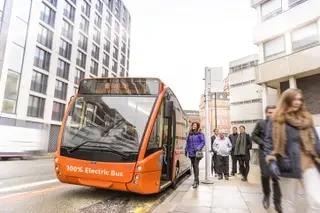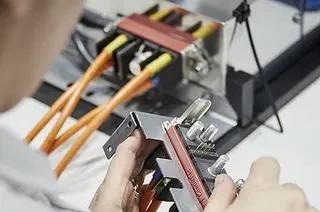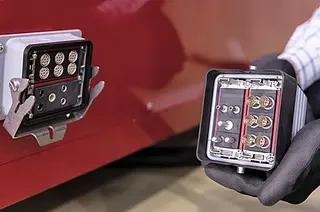Sponsored by StäubliReviewed by Olivia FrostJan 20 2023
Autonomous mobile robots (AMRs) and automated guided vehicles (AGVs) are revolutionizing the face of modern industry. The most efficient AGVs and AMRs charge quickly, intermittently, and autonomously, exerting special demands on their connectors.
Autonomous Mobile Robots and Guided Vehicles
Automated Guided Vehicles (AGVs) are mobile machines that can automatically transport goods from one location to another.
The first such vehicle was created in 1958 to transport groceries around a grocery store using an overhead wire. AGVs were first used at scale in the 1970s when Volvo, a car manufacturer, put a fleet of 280 of them to work in a ground-breaking non-synchronous production line.1
AGVs range in size from bathroom-scales to forklifts, and several are even capable of hauling payloads weighing hundreds of tons.
AMRs (autonomous mobile robots) are a closely related technology.
The specific distinction between AMRs and AGVs is up for debate, although in general, AGVs as a rule are rigorously “guided,” relying on technology such as barcodes, laser targets, and magnetic strips to follow predefined routes through their environment. AMRs, on the other hand, can make more complicated decisions: they can often calculate their own path from A to B and frequently employ full environment sensing to maneuver around objects or even interact with humans.2
Together, AGVs and AMRs are transforming the industry. Amazon has kitted out its fulfillment centers with hundreds of thousands of AGVs within the last decade.3,4 With more firms adopting automation and realizing the benefits, the AGV and AMR industry is expected to exceed $18 billion over the next five years.5
AGVs and AMRs are typically used to move things from one location to another in warehouses and factories, but they are also employed in dockyards, farms, and hospitals.6–8 As new applications are developed, and companies seek to boost automation levels and effectiveness, new species of AGVs and AMRs are being developed to accomplish an ever-expanding set of tasks.
The Importance of Connectors for AGV and AMR Applications
Connectors are overlooked when it comes to specifying an AGV or AMR for a given application – after all, in many applications, connectors are classed as trivial off-the-shelf parts. However, the opportunities and challenges presented by the adoption of AGVs and AMRs mean that their connectors cannot simply be chosen based on the current and voltage on a spec sheet.
Extreme Mating Cycle Requirements
The demand placed on any connector firstly depends on the number of mating cycles (connecting and disconnecting) that it will have to endure. For example, the charger for an electric car might have to undergo one mating cycle a day, and if the car lasts for 15 years, that is just over 5,000 mating cycles.
AGVs and AMRs, on the other hand, have substantially different requirements than “ordinary” electric vehicles. To reduce (or completely eradicate) scheduled downtime, AGVs and AMRs should be charged intermittently throughout the day, topping up their power reserves for minutes at a time when they are not actively carrying out a task or taking into account the charge levels of other robots in the fleet to maximize uptime.9
This, combined with the fact that AGVs and AMRs sometimes operate around the clock, implies that mating cycle demands on automated vehicle chargers are frequently orders of magnitude larger than for manned electric vehicles.
Self-Charging Compatibility
AGVs and AMRs benefit greatly from self-charging capabilities; after all, what good is a fleet of autonomous vehicles if human operators are required to charge them?
To overcome this issue, engineers often design features such as alignment pins or channels to ensure connectors are correctly aligned as the robot makes a connection. In a recent survey, it was also discovered that many also choose to install additional hardware – such as arm robots or linear track automation – to assist with mating.10
High Current Density for Rapid Charging
Mobile robots, unlike static machinery and most humans, cannot work and recharge at the same time. Thus, maximizing the utility of a robot fleet often entails reducing charging time.
Several AGVs and AMRs use rapid-charging power systems to do this. This puts additional strain on their connectors: in order to permit quick charging, connectors must be capable of safely and consistently supporting extremely high current densities.
Custom Modular Connectors from Stäubli
Stäubli, a world leader in robotics, automation, and connectors recognizes the demands that AGVs and AMRs place on their connectors. They also understand that the adoption of mobile robots is still in its early stages and that no two applications have the same set of needs.
Choosing the best off-the-shelf connector can be difficult and frequently entails compromise. Stäubli’s CombiTac modular connector system provides an alternative, allowing users to adjust their connectors to their demands and achieve a long-lasting, cost-effective, and high-performance connector solution.
CombiTac connectors are completely programmable using the advanced online configurator, ensuring full compatibility with AMR and AGV applications. CombiTac connectors offer:
- High current density: The proprietary MULTILAM technology offers a safe and high-contact-area connection, providing up to 350 A for rapid-charging systems
- Self-charging compatibility: CombiTac connections can be tailored to the exact dimensions and incorporate customer-specific parts for the convenience of connection in self-charging applications.
- Unparalleled durability: CombiTac connections are available with mating cycle ratings of up to 100,000, assuring consistent performance throughout the life of any AGV or AMR.
Power, signal, data, pneumatics, and fluid transmission are all possible with modular connectors.
The CombiTac Modular Connector in Action
E-Mobility

Image Credit: Stäubli Electrical Connectors
CombiTac offers a dependable and secure link for power, signal, and data transmission across the EV and autonomous vehicle production processes.
Industrial Machinery

Image Credit: Stäubli Electrical Connectors
CombiTac gives sealers, milling machines, robots, and more a consistent, secure connection that can endure vibrations and high mating forces.
Energy Storage

Image Credit: Stäubli Electrical Connectors
CombiTac provides all of the signal and data contacts required by energy storage systems in a single space-saving modular connector system.
Harsh Environments

Image Credit: Stäubli Electrical Connectors
CombiTac withstands the harsh environments prevalent in mining and railways to enable connections to power converters, ventilation groups, air conditioning, lighting and signal systems, among other things.
Aerospace

Image Credit: Stäubli Electrical Connectors
For aerospace and other transportation applications, like multimedia equipment, aircraft engine test benches, and power distribution units, CombiTac offers a reliable interface.
Medical Devices

Image Credit: Stäubli Electrical Connectors
CombiTac provides proven connectivity that ensures dependability for life-saving surgical units, diagnostic devices, and more.
References
- History of Automated Guided Vehicles.
- What’s the difference between an AMR and an AGV? Mobile Robot Guide https://mobilerobotguide.com/2021/08/06/whats-the-difference-between-an-amr-and-an-agv/ (2021).
- Amazon’s robot army has grown by 50% - Business Insider.
- Rey, J. D. How robots are transforming Amazon warehouse jobs — for better and worse. Vox https://www.vox.com/recode/2019/12/11/20982652/robots-amazon-warehouse-jobs-automation (2019).
- AGV-AMR Market to Exceed $18 Billion by 2027. logisticsIQ https://www.thelogisticsiq.com/research/automated-guided-vehicles-agv-market/ .
- Singapore mega-port implements Stäubli robot charging solution. Robotics & Automation News https://roboticsandautomationnews.com/2021/05/17/singapore-mega-port-implements-staubli-robot-charging-solution/43272/ (2021).
- Martinet, P. et al. Automatic Guided Vehicles in Agricultural and Green Space Fields. (1998).
- Pedan, M., Gregor, M. & Plinta, D. Implementation of Automated Guided Vehicle System in Healthcare Facility. Procedia Engineering 192, 665–670 (2017).
- Colling, D., Oehler, J. & Furmans, K. Battery Charging Strategies for AGV Systems. Volume 2019 Issue 12 (2019) doi:10.2195/LJ_PROC_COLLING_EN_201912_01.
- Staubli_How_are_Cable_Interconnect_Systems_Used_to_Support_Power_and_Signal_Media_Applications.pdf.

This information has been sourced, reviewed and adapted from materials provided by Stäubli Electrical Connectors .
For more information on this source, please visit Stäubli Electrical Connectors .